Business Strategy: Analysing Macro and Internal Environment of Halifax Bank
VerifiedAdded on 2023/01/12
|14
|4397
|30
AI Summary
This report analyses the impact of macro environment on Halifax Bank using PESTLE analysis. It also evaluates the internal environment and capabilities of the organization using SWOT and VRIO analysis. Additionally, it applies Porter's Five Forces model to assess the competitive advantage of the company.
Contribute Materials
Your contribution can guide someone’s learning journey. Share your
documents today.
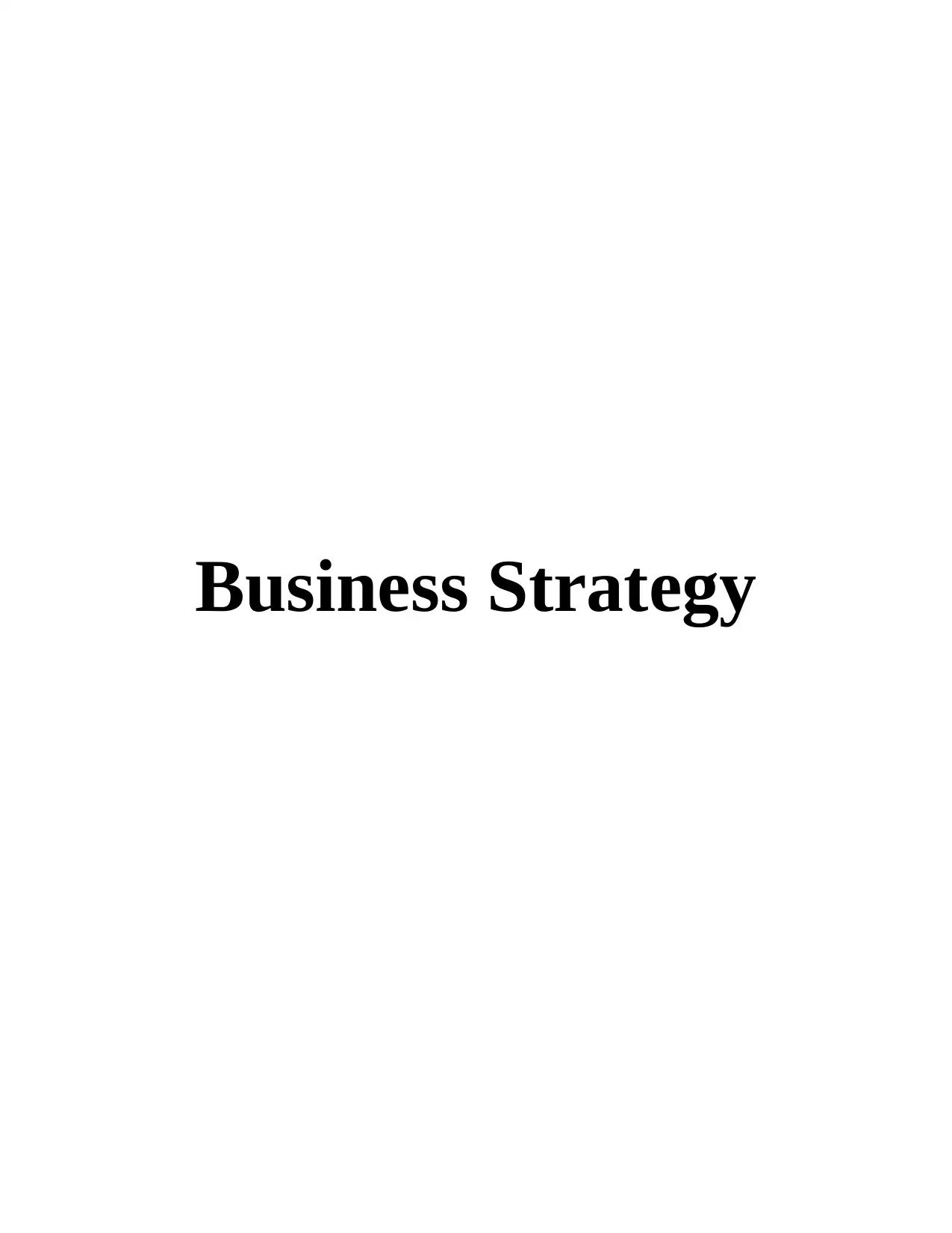
Business Strategy
Secure Best Marks with AI Grader
Need help grading? Try our AI Grader for instant feedback on your assignments.
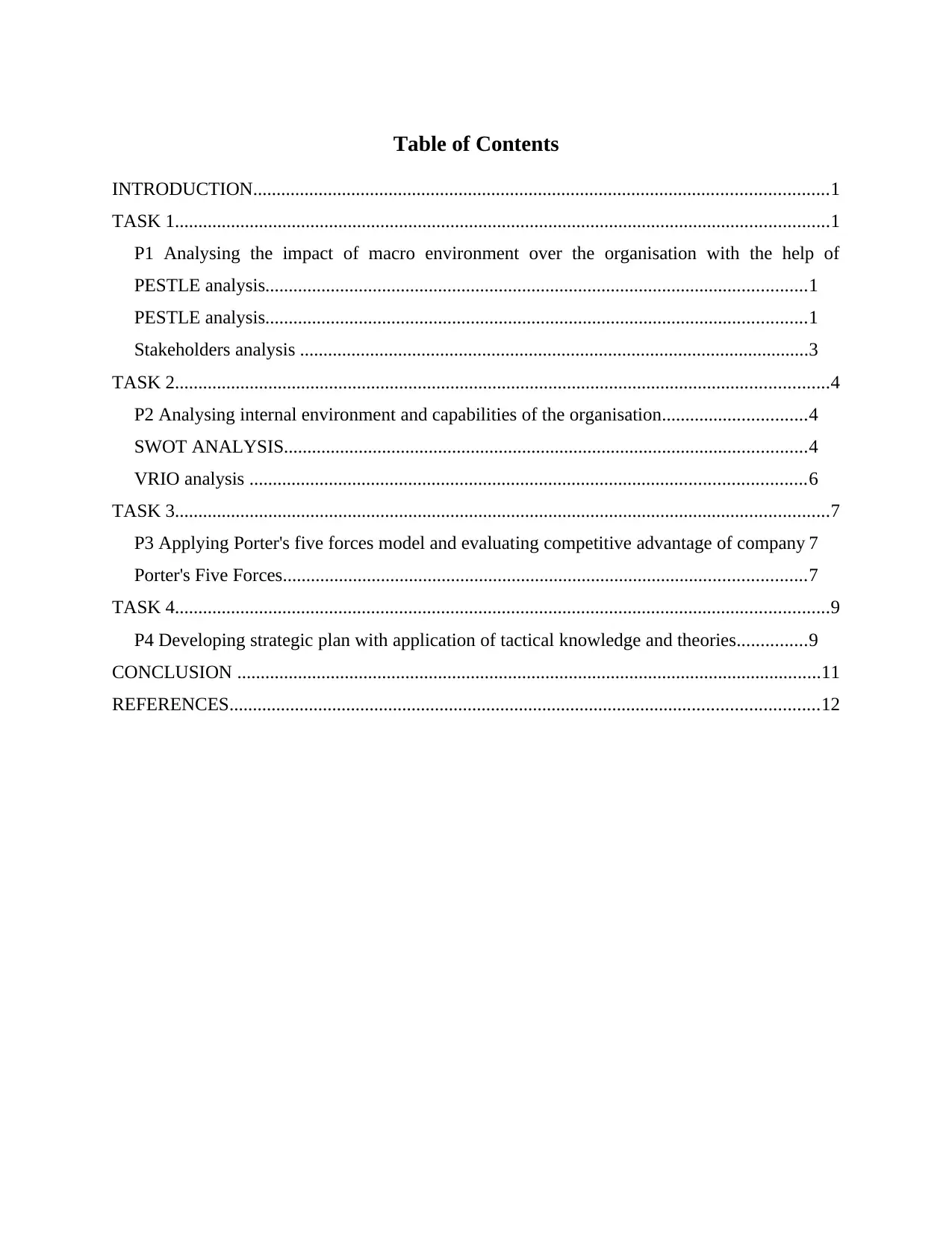
Table of Contents
INTRODUCTION...........................................................................................................................1
TASK 1............................................................................................................................................1
P1 Analysing the impact of macro environment over the organisation with the help of
PESTLE analysis....................................................................................................................1
PESTLE analysis....................................................................................................................1
Stakeholders analysis .............................................................................................................3
TASK 2............................................................................................................................................4
P2 Analysing internal environment and capabilities of the organisation...............................4
SWOT ANALYSIS................................................................................................................4
VRIO analysis .......................................................................................................................6
TASK 3............................................................................................................................................7
P3 Applying Porter's five forces model and evaluating competitive advantage of company 7
Porter's Five Forces................................................................................................................7
TASK 4............................................................................................................................................9
P4 Developing strategic plan with application of tactical knowledge and theories...............9
CONCLUSION .............................................................................................................................11
REFERENCES..............................................................................................................................12
INTRODUCTION...........................................................................................................................1
TASK 1............................................................................................................................................1
P1 Analysing the impact of macro environment over the organisation with the help of
PESTLE analysis....................................................................................................................1
PESTLE analysis....................................................................................................................1
Stakeholders analysis .............................................................................................................3
TASK 2............................................................................................................................................4
P2 Analysing internal environment and capabilities of the organisation...............................4
SWOT ANALYSIS................................................................................................................4
VRIO analysis .......................................................................................................................6
TASK 3............................................................................................................................................7
P3 Applying Porter's five forces model and evaluating competitive advantage of company 7
Porter's Five Forces................................................................................................................7
TASK 4............................................................................................................................................9
P4 Developing strategic plan with application of tactical knowledge and theories...............9
CONCLUSION .............................................................................................................................11
REFERENCES..............................................................................................................................12
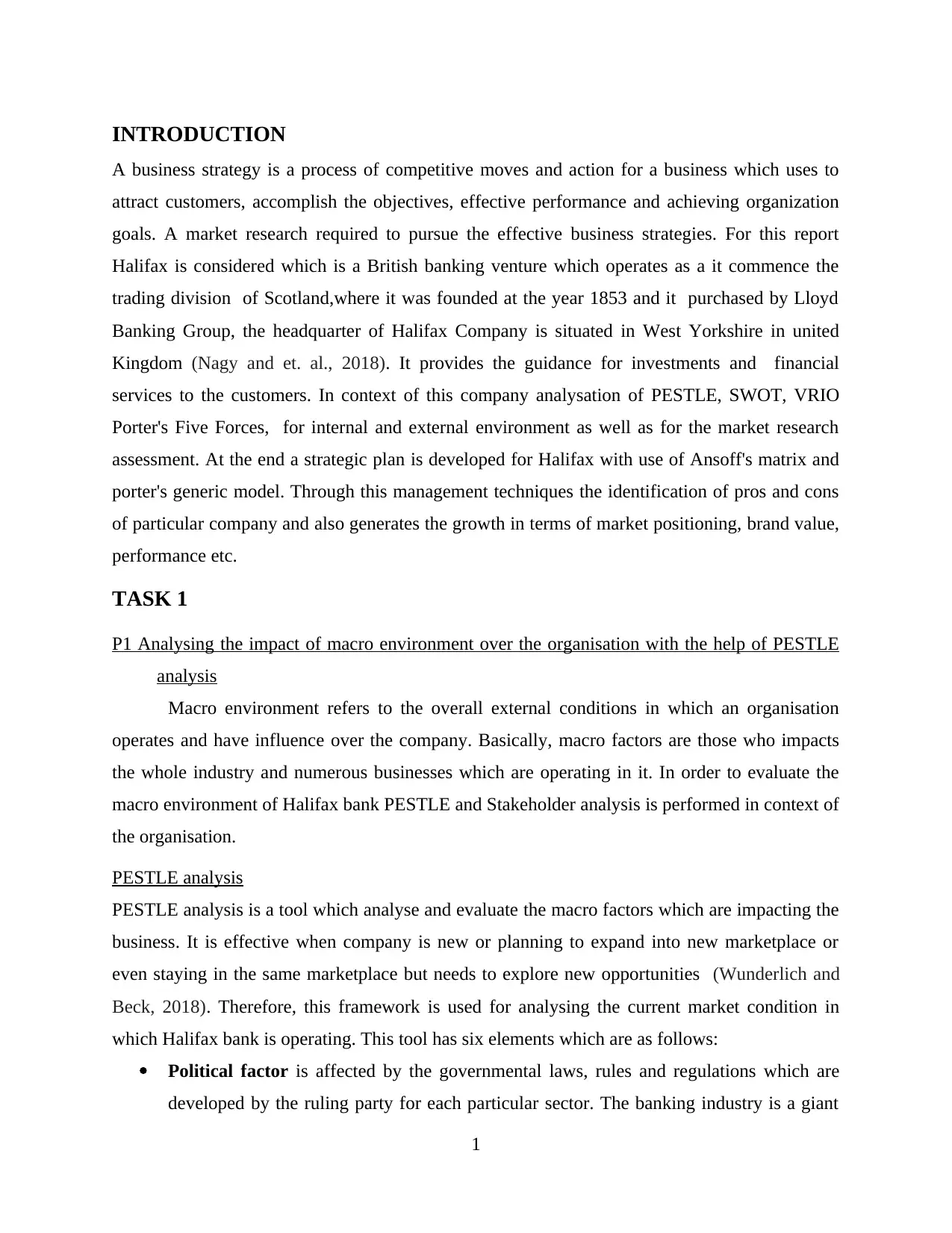
INTRODUCTION
A business strategy is a process of competitive moves and action for a business which uses to
attract customers, accomplish the objectives, effective performance and achieving organization
goals. A market research required to pursue the effective business strategies. For this report
Halifax is considered which is a British banking venture which operates as a it commence the
trading division of Scotland,where it was founded at the year 1853 and it purchased by Lloyd
Banking Group, the headquarter of Halifax Company is situated in West Yorkshire in united
Kingdom (Nagy and et. al., 2018). It provides the guidance for investments and financial
services to the customers. In context of this company analysation of PESTLE, SWOT, VRIO
Porter's Five Forces, for internal and external environment as well as for the market research
assessment. At the end a strategic plan is developed for Halifax with use of Ansoff's matrix and
porter's generic model. Through this management techniques the identification of pros and cons
of particular company and also generates the growth in terms of market positioning, brand value,
performance etc.
TASK 1
P1 Analysing the impact of macro environment over the organisation with the help of PESTLE
analysis
Macro environment refers to the overall external conditions in which an organisation
operates and have influence over the company. Basically, macro factors are those who impacts
the whole industry and numerous businesses which are operating in it. In order to evaluate the
macro environment of Halifax bank PESTLE and Stakeholder analysis is performed in context of
the organisation.
PESTLE analysis
PESTLE analysis is a tool which analyse and evaluate the macro factors which are impacting the
business. It is effective when company is new or planning to expand into new marketplace or
even staying in the same marketplace but needs to explore new opportunities (Wunderlich and
Beck, 2018). Therefore, this framework is used for analysing the current market condition in
which Halifax bank is operating. This tool has six elements which are as follows:
Political factor is affected by the governmental laws, rules and regulations which are
developed by the ruling party for each particular sector. The banking industry is a giant
1
A business strategy is a process of competitive moves and action for a business which uses to
attract customers, accomplish the objectives, effective performance and achieving organization
goals. A market research required to pursue the effective business strategies. For this report
Halifax is considered which is a British banking venture which operates as a it commence the
trading division of Scotland,where it was founded at the year 1853 and it purchased by Lloyd
Banking Group, the headquarter of Halifax Company is situated in West Yorkshire in united
Kingdom (Nagy and et. al., 2018). It provides the guidance for investments and financial
services to the customers. In context of this company analysation of PESTLE, SWOT, VRIO
Porter's Five Forces, for internal and external environment as well as for the market research
assessment. At the end a strategic plan is developed for Halifax with use of Ansoff's matrix and
porter's generic model. Through this management techniques the identification of pros and cons
of particular company and also generates the growth in terms of market positioning, brand value,
performance etc.
TASK 1
P1 Analysing the impact of macro environment over the organisation with the help of PESTLE
analysis
Macro environment refers to the overall external conditions in which an organisation
operates and have influence over the company. Basically, macro factors are those who impacts
the whole industry and numerous businesses which are operating in it. In order to evaluate the
macro environment of Halifax bank PESTLE and Stakeholder analysis is performed in context of
the organisation.
PESTLE analysis
PESTLE analysis is a tool which analyse and evaluate the macro factors which are impacting the
business. It is effective when company is new or planning to expand into new marketplace or
even staying in the same marketplace but needs to explore new opportunities (Wunderlich and
Beck, 2018). Therefore, this framework is used for analysing the current market condition in
which Halifax bank is operating. This tool has six elements which are as follows:
Political factor is affected by the governmental laws, rules and regulations which are
developed by the ruling party for each particular sector. The banking industry is a giant
1
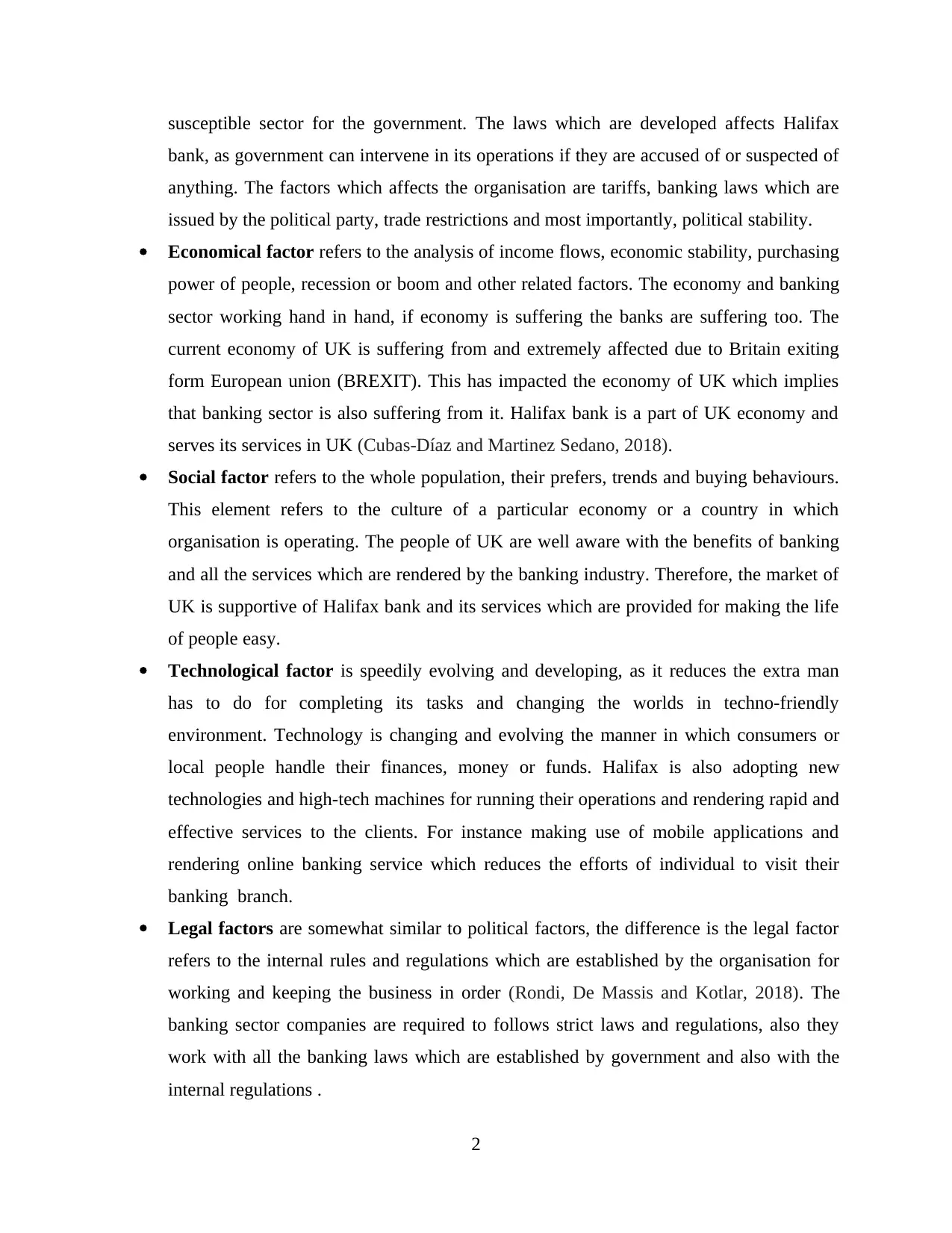
susceptible sector for the government. The laws which are developed affects Halifax
bank, as government can intervene in its operations if they are accused of or suspected of
anything. The factors which affects the organisation are tariffs, banking laws which are
issued by the political party, trade restrictions and most importantly, political stability.
Economical factor refers to the analysis of income flows, economic stability, purchasing
power of people, recession or boom and other related factors. The economy and banking
sector working hand in hand, if economy is suffering the banks are suffering too. The
current economy of UK is suffering from and extremely affected due to Britain exiting
form European union (BREXIT). This has impacted the economy of UK which implies
that banking sector is also suffering from it. Halifax bank is a part of UK economy and
serves its services in UK (Cubas‐Díaz and Martinez Sedano, 2018).
Social factor refers to the whole population, their prefers, trends and buying behaviours.
This element refers to the culture of a particular economy or a country in which
organisation is operating. The people of UK are well aware with the benefits of banking
and all the services which are rendered by the banking industry. Therefore, the market of
UK is supportive of Halifax bank and its services which are provided for making the life
of people easy.
Technological factor is speedily evolving and developing, as it reduces the extra man
has to do for completing its tasks and changing the worlds in techno-friendly
environment. Technology is changing and evolving the manner in which consumers or
local people handle their finances, money or funds. Halifax is also adopting new
technologies and high-tech machines for running their operations and rendering rapid and
effective services to the clients. For instance making use of mobile applications and
rendering online banking service which reduces the efforts of individual to visit their
banking branch.
Legal factors are somewhat similar to political factors, the difference is the legal factor
refers to the internal rules and regulations which are established by the organisation for
working and keeping the business in order (Rondi, De Massis and Kotlar, 2018). The
banking sector companies are required to follows strict laws and regulations, also they
work with all the banking laws which are established by government and also with the
internal regulations .
2
bank, as government can intervene in its operations if they are accused of or suspected of
anything. The factors which affects the organisation are tariffs, banking laws which are
issued by the political party, trade restrictions and most importantly, political stability.
Economical factor refers to the analysis of income flows, economic stability, purchasing
power of people, recession or boom and other related factors. The economy and banking
sector working hand in hand, if economy is suffering the banks are suffering too. The
current economy of UK is suffering from and extremely affected due to Britain exiting
form European union (BREXIT). This has impacted the economy of UK which implies
that banking sector is also suffering from it. Halifax bank is a part of UK economy and
serves its services in UK (Cubas‐Díaz and Martinez Sedano, 2018).
Social factor refers to the whole population, their prefers, trends and buying behaviours.
This element refers to the culture of a particular economy or a country in which
organisation is operating. The people of UK are well aware with the benefits of banking
and all the services which are rendered by the banking industry. Therefore, the market of
UK is supportive of Halifax bank and its services which are provided for making the life
of people easy.
Technological factor is speedily evolving and developing, as it reduces the extra man
has to do for completing its tasks and changing the worlds in techno-friendly
environment. Technology is changing and evolving the manner in which consumers or
local people handle their finances, money or funds. Halifax is also adopting new
technologies and high-tech machines for running their operations and rendering rapid and
effective services to the clients. For instance making use of mobile applications and
rendering online banking service which reduces the efforts of individual to visit their
banking branch.
Legal factors are somewhat similar to political factors, the difference is the legal factor
refers to the internal rules and regulations which are established by the organisation for
working and keeping the business in order (Rondi, De Massis and Kotlar, 2018). The
banking sector companies are required to follows strict laws and regulations, also they
work with all the banking laws which are established by government and also with the
internal regulations .
2
Secure Best Marks with AI Grader
Need help grading? Try our AI Grader for instant feedback on your assignments.
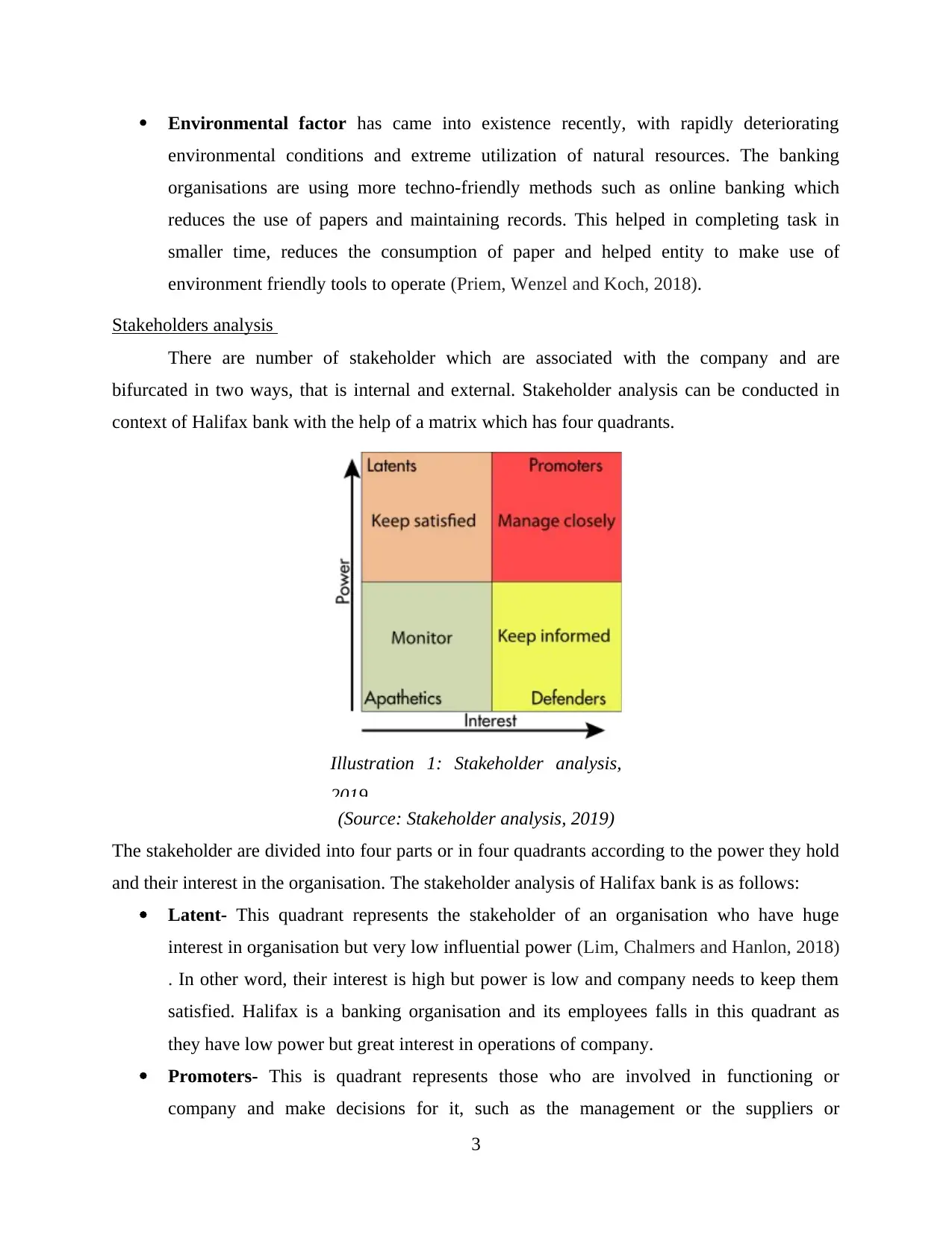
Environmental factor has came into existence recently, with rapidly deteriorating
environmental conditions and extreme utilization of natural resources. The banking
organisations are using more techno-friendly methods such as online banking which
reduces the use of papers and maintaining records. This helped in completing task in
smaller time, reduces the consumption of paper and helped entity to make use of
environment friendly tools to operate (Priem, Wenzel and Koch, 2018).
Stakeholders analysis
There are number of stakeholder which are associated with the company and are
bifurcated in two ways, that is internal and external. Stakeholder analysis can be conducted in
context of Halifax bank with the help of a matrix which has four quadrants.
(Source: Stakeholder analysis, 2019)
The stakeholder are divided into four parts or in four quadrants according to the power they hold
and their interest in the organisation. The stakeholder analysis of Halifax bank is as follows:
Latent- This quadrant represents the stakeholder of an organisation who have huge
interest in organisation but very low influential power (Lim, Chalmers and Hanlon, 2018)
. In other word, their interest is high but power is low and company needs to keep them
satisfied. Halifax is a banking organisation and its employees falls in this quadrant as
they have low power but great interest in operations of company.
Promoters- This is quadrant represents those who are involved in functioning or
company and make decisions for it, such as the management or the suppliers or
3
Illustration 1: Stakeholder analysis,
2019
environmental conditions and extreme utilization of natural resources. The banking
organisations are using more techno-friendly methods such as online banking which
reduces the use of papers and maintaining records. This helped in completing task in
smaller time, reduces the consumption of paper and helped entity to make use of
environment friendly tools to operate (Priem, Wenzel and Koch, 2018).
Stakeholders analysis
There are number of stakeholder which are associated with the company and are
bifurcated in two ways, that is internal and external. Stakeholder analysis can be conducted in
context of Halifax bank with the help of a matrix which has four quadrants.
(Source: Stakeholder analysis, 2019)
The stakeholder are divided into four parts or in four quadrants according to the power they hold
and their interest in the organisation. The stakeholder analysis of Halifax bank is as follows:
Latent- This quadrant represents the stakeholder of an organisation who have huge
interest in organisation but very low influential power (Lim, Chalmers and Hanlon, 2018)
. In other word, their interest is high but power is low and company needs to keep them
satisfied. Halifax is a banking organisation and its employees falls in this quadrant as
they have low power but great interest in operations of company.
Promoters- This is quadrant represents those who are involved in functioning or
company and make decisions for it, such as the management or the suppliers or
3
Illustration 1: Stakeholder analysis,
2019
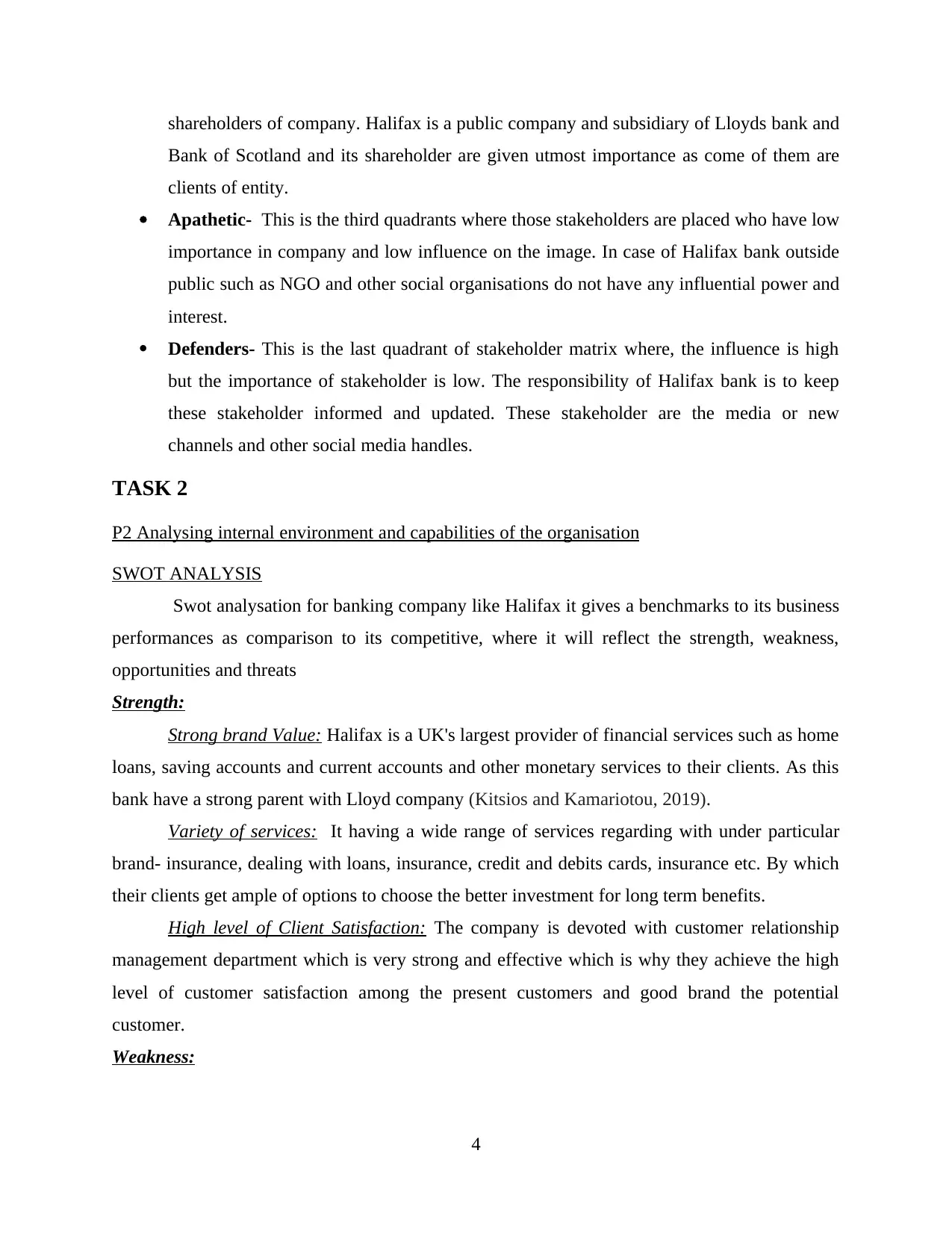
shareholders of company. Halifax is a public company and subsidiary of Lloyds bank and
Bank of Scotland and its shareholder are given utmost importance as come of them are
clients of entity.
Apathetic- This is the third quadrants where those stakeholders are placed who have low
importance in company and low influence on the image. In case of Halifax bank outside
public such as NGO and other social organisations do not have any influential power and
interest.
Defenders- This is the last quadrant of stakeholder matrix where, the influence is high
but the importance of stakeholder is low. The responsibility of Halifax bank is to keep
these stakeholder informed and updated. These stakeholder are the media or new
channels and other social media handles.
TASK 2
P2 Analysing internal environment and capabilities of the organisation
SWOT ANALYSIS
Swot analysation for banking company like Halifax it gives a benchmarks to its business
performances as comparison to its competitive, where it will reflect the strength, weakness,
opportunities and threats
Strength:
Strong brand Value: Halifax is a UK's largest provider of financial services such as home
loans, saving accounts and current accounts and other monetary services to their clients. As this
bank have a strong parent with Lloyd company (Kitsios and Kamariotou, 2019).
Variety of services: It having a wide range of services regarding with under particular
brand- insurance, dealing with loans, insurance, credit and debits cards, insurance etc. By which
their clients get ample of options to choose the better investment for long term benefits.
High level of Client Satisfaction: The company is devoted with customer relationship
management department which is very strong and effective which is why they achieve the high
level of customer satisfaction among the present customers and good brand the potential
customer.
Weakness:
4
Bank of Scotland and its shareholder are given utmost importance as come of them are
clients of entity.
Apathetic- This is the third quadrants where those stakeholders are placed who have low
importance in company and low influence on the image. In case of Halifax bank outside
public such as NGO and other social organisations do not have any influential power and
interest.
Defenders- This is the last quadrant of stakeholder matrix where, the influence is high
but the importance of stakeholder is low. The responsibility of Halifax bank is to keep
these stakeholder informed and updated. These stakeholder are the media or new
channels and other social media handles.
TASK 2
P2 Analysing internal environment and capabilities of the organisation
SWOT ANALYSIS
Swot analysation for banking company like Halifax it gives a benchmarks to its business
performances as comparison to its competitive, where it will reflect the strength, weakness,
opportunities and threats
Strength:
Strong brand Value: Halifax is a UK's largest provider of financial services such as home
loans, saving accounts and current accounts and other monetary services to their clients. As this
bank have a strong parent with Lloyd company (Kitsios and Kamariotou, 2019).
Variety of services: It having a wide range of services regarding with under particular
brand- insurance, dealing with loans, insurance, credit and debits cards, insurance etc. By which
their clients get ample of options to choose the better investment for long term benefits.
High level of Client Satisfaction: The company is devoted with customer relationship
management department which is very strong and effective which is why they achieve the high
level of customer satisfaction among the present customers and good brand the potential
customer.
Weakness:
4
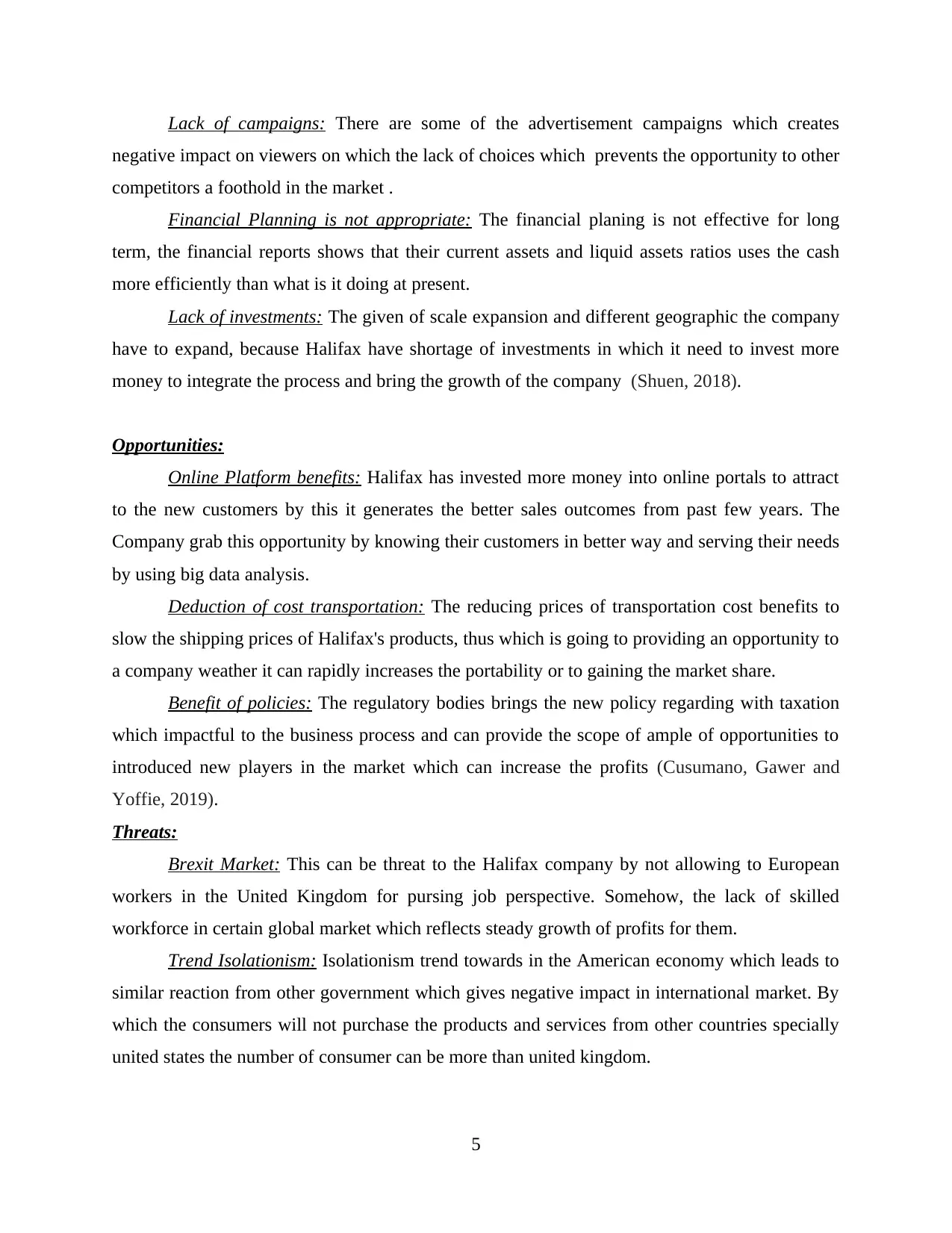
Lack of campaigns: There are some of the advertisement campaigns which creates
negative impact on viewers on which the lack of choices which prevents the opportunity to other
competitors a foothold in the market .
Financial Planning is not appropriate: The financial planing is not effective for long
term, the financial reports shows that their current assets and liquid assets ratios uses the cash
more efficiently than what is it doing at present.
Lack of investments: The given of scale expansion and different geographic the company
have to expand, because Halifax have shortage of investments in which it need to invest more
money to integrate the process and bring the growth of the company (Shuen, 2018).
Opportunities:
Online Platform benefits: Halifax has invested more money into online portals to attract
to the new customers by this it generates the better sales outcomes from past few years. The
Company grab this opportunity by knowing their customers in better way and serving their needs
by using big data analysis.
Deduction of cost transportation: The reducing prices of transportation cost benefits to
slow the shipping prices of Halifax's products, thus which is going to providing an opportunity to
a company weather it can rapidly increases the portability or to gaining the market share.
Benefit of policies: The regulatory bodies brings the new policy regarding with taxation
which impactful to the business process and can provide the scope of ample of opportunities to
introduced new players in the market which can increase the profits (Cusumano, Gawer and
Yoffie, 2019).
Threats:
Brexit Market: This can be threat to the Halifax company by not allowing to European
workers in the United Kingdom for pursing job perspective. Somehow, the lack of skilled
workforce in certain global market which reflects steady growth of profits for them.
Trend Isolationism: Isolationism trend towards in the American economy which leads to
similar reaction from other government which gives negative impact in international market. By
which the consumers will not purchase the products and services from other countries specially
united states the number of consumer can be more than united kingdom.
5
negative impact on viewers on which the lack of choices which prevents the opportunity to other
competitors a foothold in the market .
Financial Planning is not appropriate: The financial planing is not effective for long
term, the financial reports shows that their current assets and liquid assets ratios uses the cash
more efficiently than what is it doing at present.
Lack of investments: The given of scale expansion and different geographic the company
have to expand, because Halifax have shortage of investments in which it need to invest more
money to integrate the process and bring the growth of the company (Shuen, 2018).
Opportunities:
Online Platform benefits: Halifax has invested more money into online portals to attract
to the new customers by this it generates the better sales outcomes from past few years. The
Company grab this opportunity by knowing their customers in better way and serving their needs
by using big data analysis.
Deduction of cost transportation: The reducing prices of transportation cost benefits to
slow the shipping prices of Halifax's products, thus which is going to providing an opportunity to
a company weather it can rapidly increases the portability or to gaining the market share.
Benefit of policies: The regulatory bodies brings the new policy regarding with taxation
which impactful to the business process and can provide the scope of ample of opportunities to
introduced new players in the market which can increase the profits (Cusumano, Gawer and
Yoffie, 2019).
Threats:
Brexit Market: This can be threat to the Halifax company by not allowing to European
workers in the United Kingdom for pursing job perspective. Somehow, the lack of skilled
workforce in certain global market which reflects steady growth of profits for them.
Trend Isolationism: Isolationism trend towards in the American economy which leads to
similar reaction from other government which gives negative impact in international market. By
which the consumers will not purchase the products and services from other countries specially
united states the number of consumer can be more than united kingdom.
5
Paraphrase This Document
Need a fresh take? Get an instant paraphrase of this document with our AI Paraphraser
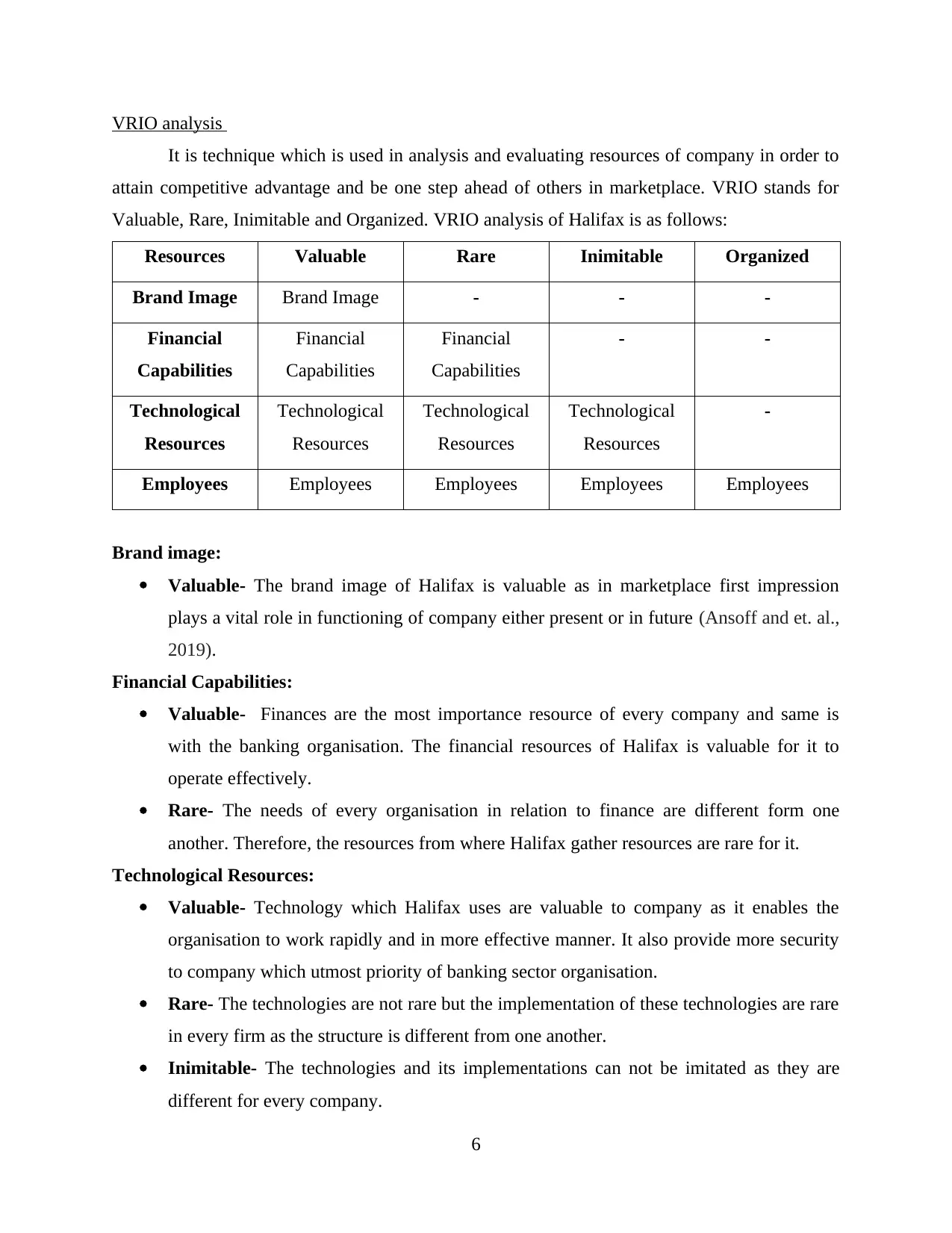
VRIO analysis
It is technique which is used in analysis and evaluating resources of company in order to
attain competitive advantage and be one step ahead of others in marketplace. VRIO stands for
Valuable, Rare, Inimitable and Organized. VRIO analysis of Halifax is as follows:
Resources Valuable Rare Inimitable Organized
Brand Image Brand Image - - -
Financial
Capabilities
Financial
Capabilities
Financial
Capabilities
- -
Technological
Resources
Technological
Resources
Technological
Resources
Technological
Resources
-
Employees Employees Employees Employees Employees
Brand image:
Valuable- The brand image of Halifax is valuable as in marketplace first impression
plays a vital role in functioning of company either present or in future (Ansoff and et. al.,
2019).
Financial Capabilities:
Valuable- Finances are the most importance resource of every company and same is
with the banking organisation. The financial resources of Halifax is valuable for it to
operate effectively.
Rare- The needs of every organisation in relation to finance are different form one
another. Therefore, the resources from where Halifax gather resources are rare for it.
Technological Resources:
Valuable- Technology which Halifax uses are valuable to company as it enables the
organisation to work rapidly and in more effective manner. It also provide more security
to company which utmost priority of banking sector organisation.
Rare- The technologies are not rare but the implementation of these technologies are rare
in every firm as the structure is different from one another.
Inimitable- The technologies and its implementations can not be imitated as they are
different for every company.
6
It is technique which is used in analysis and evaluating resources of company in order to
attain competitive advantage and be one step ahead of others in marketplace. VRIO stands for
Valuable, Rare, Inimitable and Organized. VRIO analysis of Halifax is as follows:
Resources Valuable Rare Inimitable Organized
Brand Image Brand Image - - -
Financial
Capabilities
Financial
Capabilities
Financial
Capabilities
- -
Technological
Resources
Technological
Resources
Technological
Resources
Technological
Resources
-
Employees Employees Employees Employees Employees
Brand image:
Valuable- The brand image of Halifax is valuable as in marketplace first impression
plays a vital role in functioning of company either present or in future (Ansoff and et. al.,
2019).
Financial Capabilities:
Valuable- Finances are the most importance resource of every company and same is
with the banking organisation. The financial resources of Halifax is valuable for it to
operate effectively.
Rare- The needs of every organisation in relation to finance are different form one
another. Therefore, the resources from where Halifax gather resources are rare for it.
Technological Resources:
Valuable- Technology which Halifax uses are valuable to company as it enables the
organisation to work rapidly and in more effective manner. It also provide more security
to company which utmost priority of banking sector organisation.
Rare- The technologies are not rare but the implementation of these technologies are rare
in every firm as the structure is different from one another.
Inimitable- The technologies and its implementations can not be imitated as they are
different for every company.
6
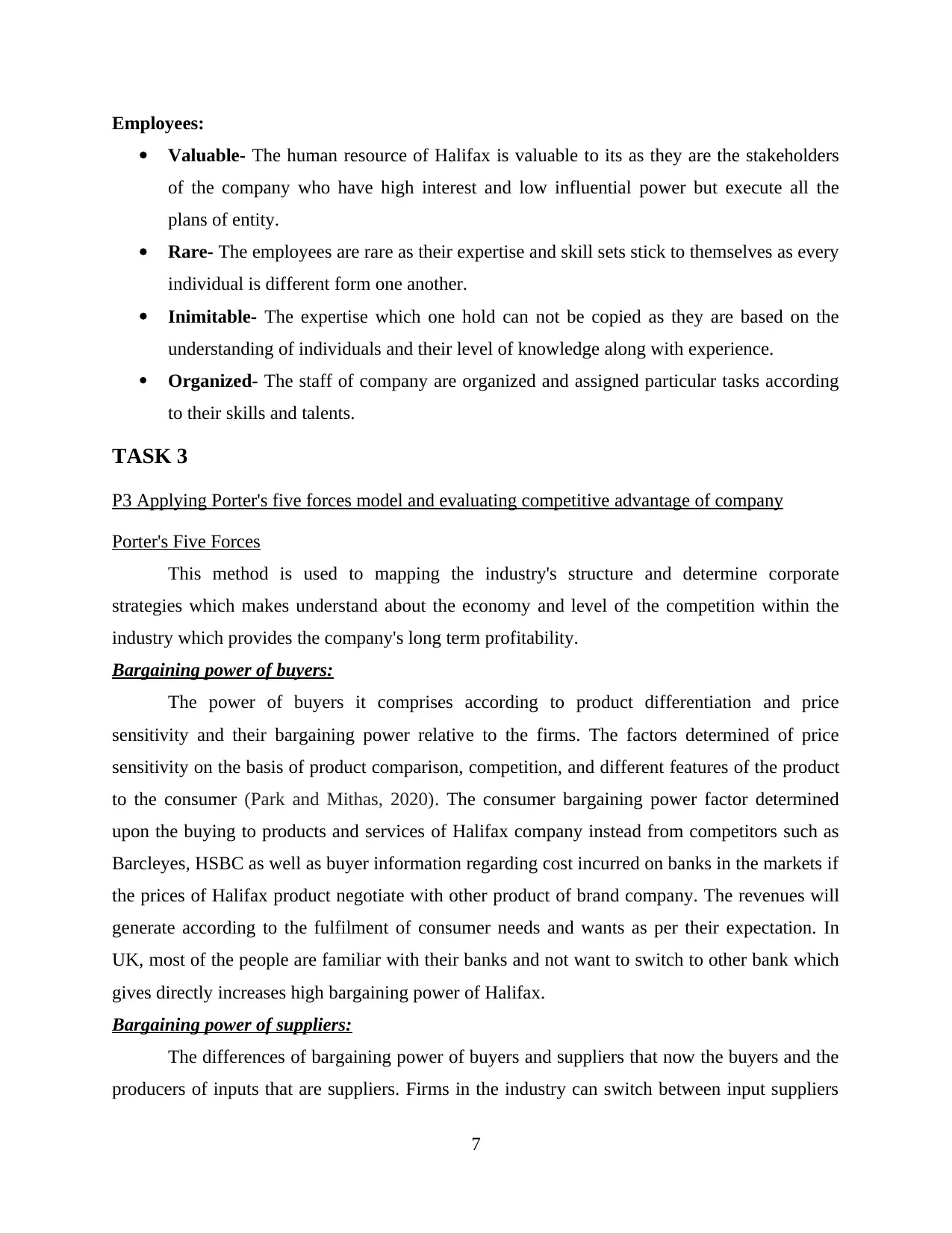
Employees:
Valuable- The human resource of Halifax is valuable to its as they are the stakeholders
of the company who have high interest and low influential power but execute all the
plans of entity.
Rare- The employees are rare as their expertise and skill sets stick to themselves as every
individual is different form one another.
Inimitable- The expertise which one hold can not be copied as they are based on the
understanding of individuals and their level of knowledge along with experience.
Organized- The staff of company are organized and assigned particular tasks according
to their skills and talents.
TASK 3
P3 Applying Porter's five forces model and evaluating competitive advantage of company
Porter's Five Forces
This method is used to mapping the industry's structure and determine corporate
strategies which makes understand about the economy and level of the competition within the
industry which provides the company's long term profitability.
Bargaining power of buyers:
The power of buyers it comprises according to product differentiation and price
sensitivity and their bargaining power relative to the firms. The factors determined of price
sensitivity on the basis of product comparison, competition, and different features of the product
to the consumer (Park and Mithas, 2020). The consumer bargaining power factor determined
upon the buying to products and services of Halifax company instead from competitors such as
Barcleyes, HSBC as well as buyer information regarding cost incurred on banks in the markets if
the prices of Halifax product negotiate with other product of brand company. The revenues will
generate according to the fulfilment of consumer needs and wants as per their expectation. In
UK, most of the people are familiar with their banks and not want to switch to other bank which
gives directly increases high bargaining power of Halifax.
Bargaining power of suppliers:
The differences of bargaining power of buyers and suppliers that now the buyers and the
producers of inputs that are suppliers. Firms in the industry can switch between input suppliers
7
Valuable- The human resource of Halifax is valuable to its as they are the stakeholders
of the company who have high interest and low influential power but execute all the
plans of entity.
Rare- The employees are rare as their expertise and skill sets stick to themselves as every
individual is different form one another.
Inimitable- The expertise which one hold can not be copied as they are based on the
understanding of individuals and their level of knowledge along with experience.
Organized- The staff of company are organized and assigned particular tasks according
to their skills and talents.
TASK 3
P3 Applying Porter's five forces model and evaluating competitive advantage of company
Porter's Five Forces
This method is used to mapping the industry's structure and determine corporate
strategies which makes understand about the economy and level of the competition within the
industry which provides the company's long term profitability.
Bargaining power of buyers:
The power of buyers it comprises according to product differentiation and price
sensitivity and their bargaining power relative to the firms. The factors determined of price
sensitivity on the basis of product comparison, competition, and different features of the product
to the consumer (Park and Mithas, 2020). The consumer bargaining power factor determined
upon the buying to products and services of Halifax company instead from competitors such as
Barcleyes, HSBC as well as buyer information regarding cost incurred on banks in the markets if
the prices of Halifax product negotiate with other product of brand company. The revenues will
generate according to the fulfilment of consumer needs and wants as per their expectation. In
UK, most of the people are familiar with their banks and not want to switch to other bank which
gives directly increases high bargaining power of Halifax.
Bargaining power of suppliers:
The differences of bargaining power of buyers and suppliers that now the buyers and the
producers of inputs that are suppliers. Firms in the industry can switch between input suppliers
7
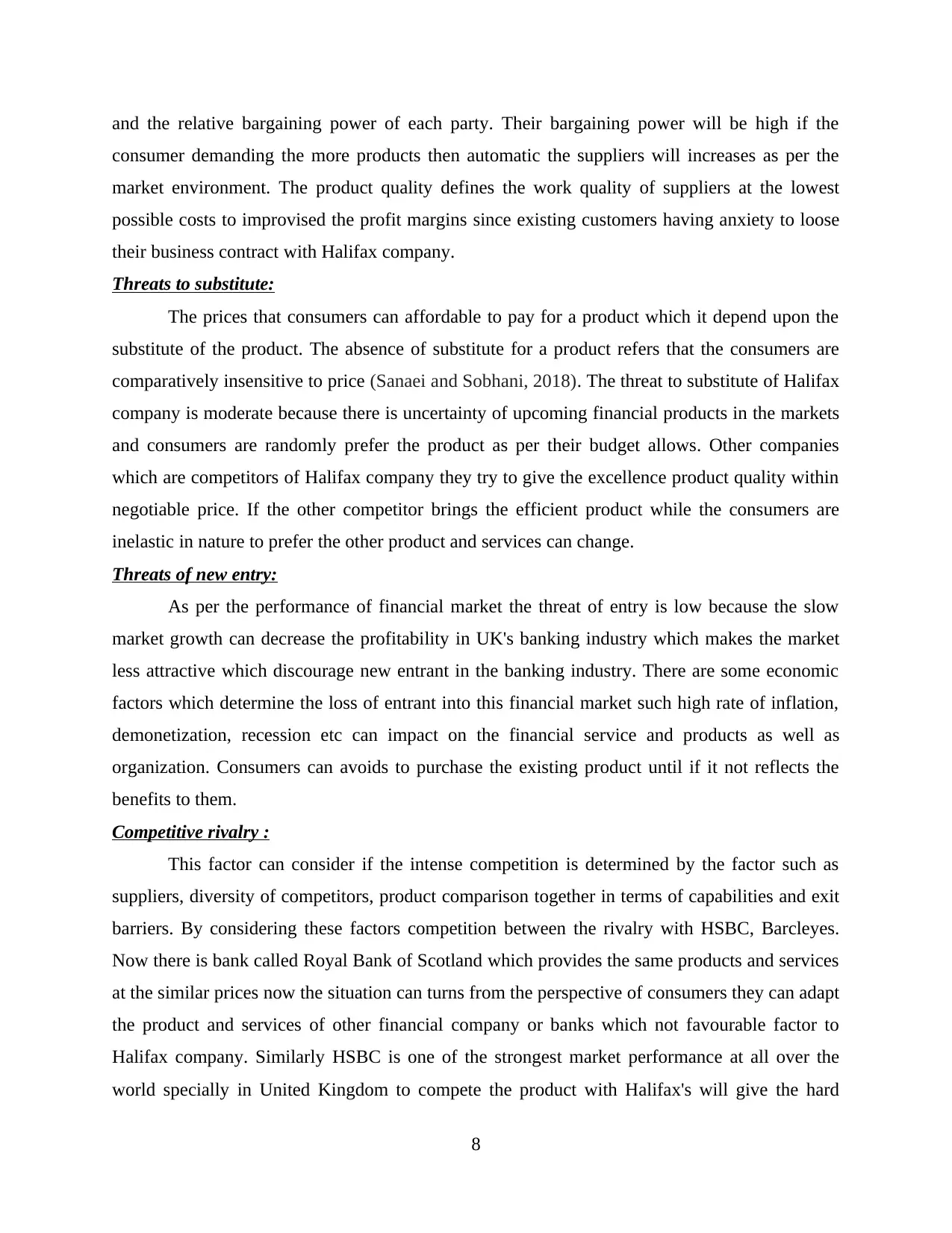
and the relative bargaining power of each party. Their bargaining power will be high if the
consumer demanding the more products then automatic the suppliers will increases as per the
market environment. The product quality defines the work quality of suppliers at the lowest
possible costs to improvised the profit margins since existing customers having anxiety to loose
their business contract with Halifax company.
Threats to substitute:
The prices that consumers can affordable to pay for a product which it depend upon the
substitute of the product. The absence of substitute for a product refers that the consumers are
comparatively insensitive to price (Sanaei and Sobhani, 2018). The threat to substitute of Halifax
company is moderate because there is uncertainty of upcoming financial products in the markets
and consumers are randomly prefer the product as per their budget allows. Other companies
which are competitors of Halifax company they try to give the excellence product quality within
negotiable price. If the other competitor brings the efficient product while the consumers are
inelastic in nature to prefer the other product and services can change.
Threats of new entry:
As per the performance of financial market the threat of entry is low because the slow
market growth can decrease the profitability in UK's banking industry which makes the market
less attractive which discourage new entrant in the banking industry. There are some economic
factors which determine the loss of entrant into this financial market such high rate of inflation,
demonetization, recession etc can impact on the financial service and products as well as
organization. Consumers can avoids to purchase the existing product until if it not reflects the
benefits to them.
Competitive rivalry :
This factor can consider if the intense competition is determined by the factor such as
suppliers, diversity of competitors, product comparison together in terms of capabilities and exit
barriers. By considering these factors competition between the rivalry with HSBC, Barcleyes.
Now there is bank called Royal Bank of Scotland which provides the same products and services
at the similar prices now the situation can turns from the perspective of consumers they can adapt
the product and services of other financial company or banks which not favourable factor to
Halifax company. Similarly HSBC is one of the strongest market performance at all over the
world specially in United Kingdom to compete the product with Halifax's will give the hard
8
consumer demanding the more products then automatic the suppliers will increases as per the
market environment. The product quality defines the work quality of suppliers at the lowest
possible costs to improvised the profit margins since existing customers having anxiety to loose
their business contract with Halifax company.
Threats to substitute:
The prices that consumers can affordable to pay for a product which it depend upon the
substitute of the product. The absence of substitute for a product refers that the consumers are
comparatively insensitive to price (Sanaei and Sobhani, 2018). The threat to substitute of Halifax
company is moderate because there is uncertainty of upcoming financial products in the markets
and consumers are randomly prefer the product as per their budget allows. Other companies
which are competitors of Halifax company they try to give the excellence product quality within
negotiable price. If the other competitor brings the efficient product while the consumers are
inelastic in nature to prefer the other product and services can change.
Threats of new entry:
As per the performance of financial market the threat of entry is low because the slow
market growth can decrease the profitability in UK's banking industry which makes the market
less attractive which discourage new entrant in the banking industry. There are some economic
factors which determine the loss of entrant into this financial market such high rate of inflation,
demonetization, recession etc can impact on the financial service and products as well as
organization. Consumers can avoids to purchase the existing product until if it not reflects the
benefits to them.
Competitive rivalry :
This factor can consider if the intense competition is determined by the factor such as
suppliers, diversity of competitors, product comparison together in terms of capabilities and exit
barriers. By considering these factors competition between the rivalry with HSBC, Barcleyes.
Now there is bank called Royal Bank of Scotland which provides the same products and services
at the similar prices now the situation can turns from the perspective of consumers they can adapt
the product and services of other financial company or banks which not favourable factor to
Halifax company. Similarly HSBC is one of the strongest market performance at all over the
world specially in United Kingdom to compete the product with Halifax's will give the hard
8
Secure Best Marks with AI Grader
Need help grading? Try our AI Grader for instant feedback on your assignments.
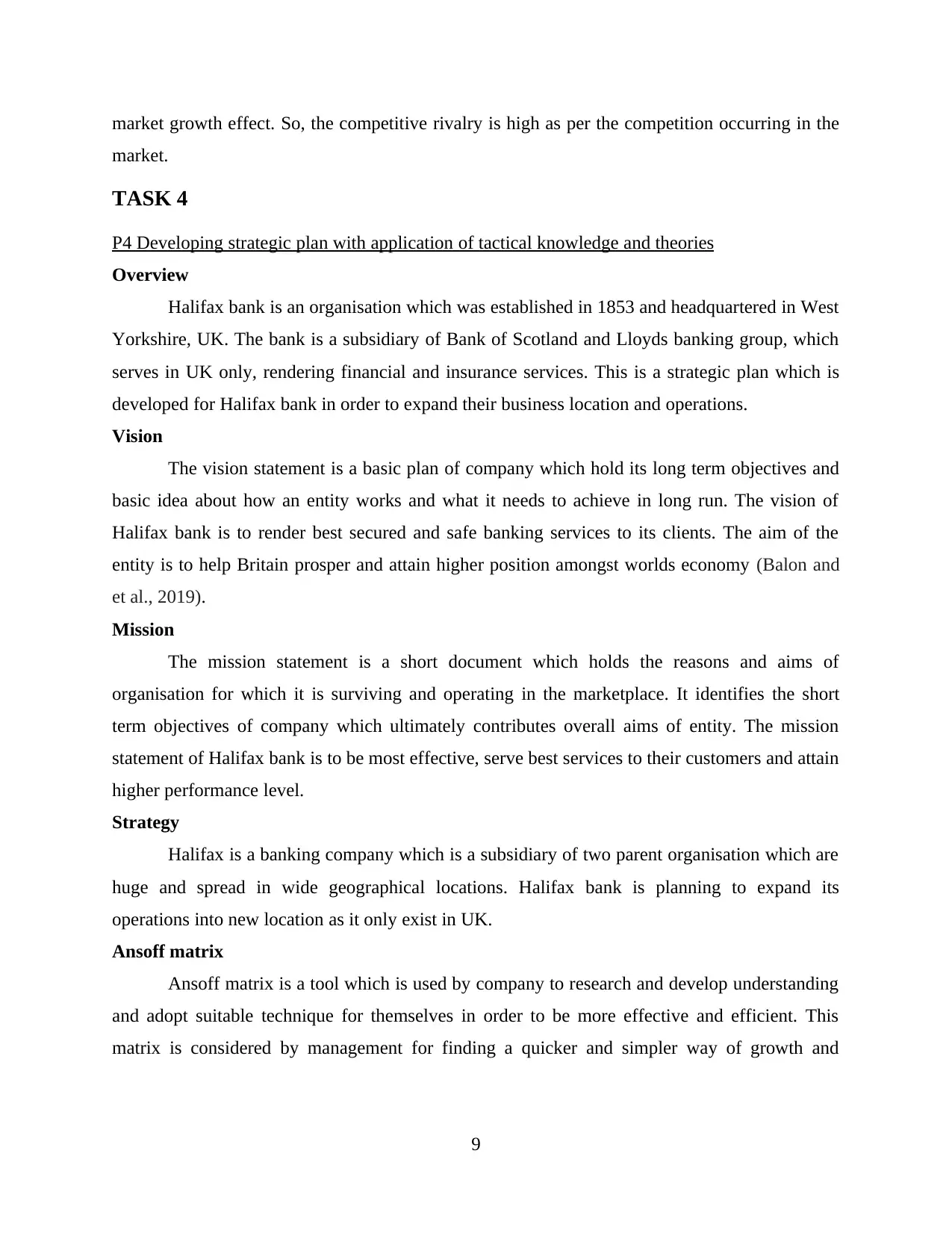
market growth effect. So, the competitive rivalry is high as per the competition occurring in the
market.
TASK 4
P4 Developing strategic plan with application of tactical knowledge and theories
Overview
Halifax bank is an organisation which was established in 1853 and headquartered in West
Yorkshire, UK. The bank is a subsidiary of Bank of Scotland and Lloyds banking group, which
serves in UK only, rendering financial and insurance services. This is a strategic plan which is
developed for Halifax bank in order to expand their business location and operations.
Vision
The vision statement is a basic plan of company which hold its long term objectives and
basic idea about how an entity works and what it needs to achieve in long run. The vision of
Halifax bank is to render best secured and safe banking services to its clients. The aim of the
entity is to help Britain prosper and attain higher position amongst worlds economy (Balon and
et al., 2019).
Mission
The mission statement is a short document which holds the reasons and aims of
organisation for which it is surviving and operating in the marketplace. It identifies the short
term objectives of company which ultimately contributes overall aims of entity. The mission
statement of Halifax bank is to be most effective, serve best services to their customers and attain
higher performance level.
Strategy
Halifax is a banking company which is a subsidiary of two parent organisation which are
huge and spread in wide geographical locations. Halifax bank is planning to expand its
operations into new location as it only exist in UK.
Ansoff matrix
Ansoff matrix is a tool which is used by company to research and develop understanding
and adopt suitable technique for themselves in order to be more effective and efficient. This
matrix is considered by management for finding a quicker and simpler way of growth and
9
market.
TASK 4
P4 Developing strategic plan with application of tactical knowledge and theories
Overview
Halifax bank is an organisation which was established in 1853 and headquartered in West
Yorkshire, UK. The bank is a subsidiary of Bank of Scotland and Lloyds banking group, which
serves in UK only, rendering financial and insurance services. This is a strategic plan which is
developed for Halifax bank in order to expand their business location and operations.
Vision
The vision statement is a basic plan of company which hold its long term objectives and
basic idea about how an entity works and what it needs to achieve in long run. The vision of
Halifax bank is to render best secured and safe banking services to its clients. The aim of the
entity is to help Britain prosper and attain higher position amongst worlds economy (Balon and
et al., 2019).
Mission
The mission statement is a short document which holds the reasons and aims of
organisation for which it is surviving and operating in the marketplace. It identifies the short
term objectives of company which ultimately contributes overall aims of entity. The mission
statement of Halifax bank is to be most effective, serve best services to their customers and attain
higher performance level.
Strategy
Halifax is a banking company which is a subsidiary of two parent organisation which are
huge and spread in wide geographical locations. Halifax bank is planning to expand its
operations into new location as it only exist in UK.
Ansoff matrix
Ansoff matrix is a tool which is used by company to research and develop understanding
and adopt suitable technique for themselves in order to be more effective and efficient. This
matrix is considered by management for finding a quicker and simpler way of growth and
9
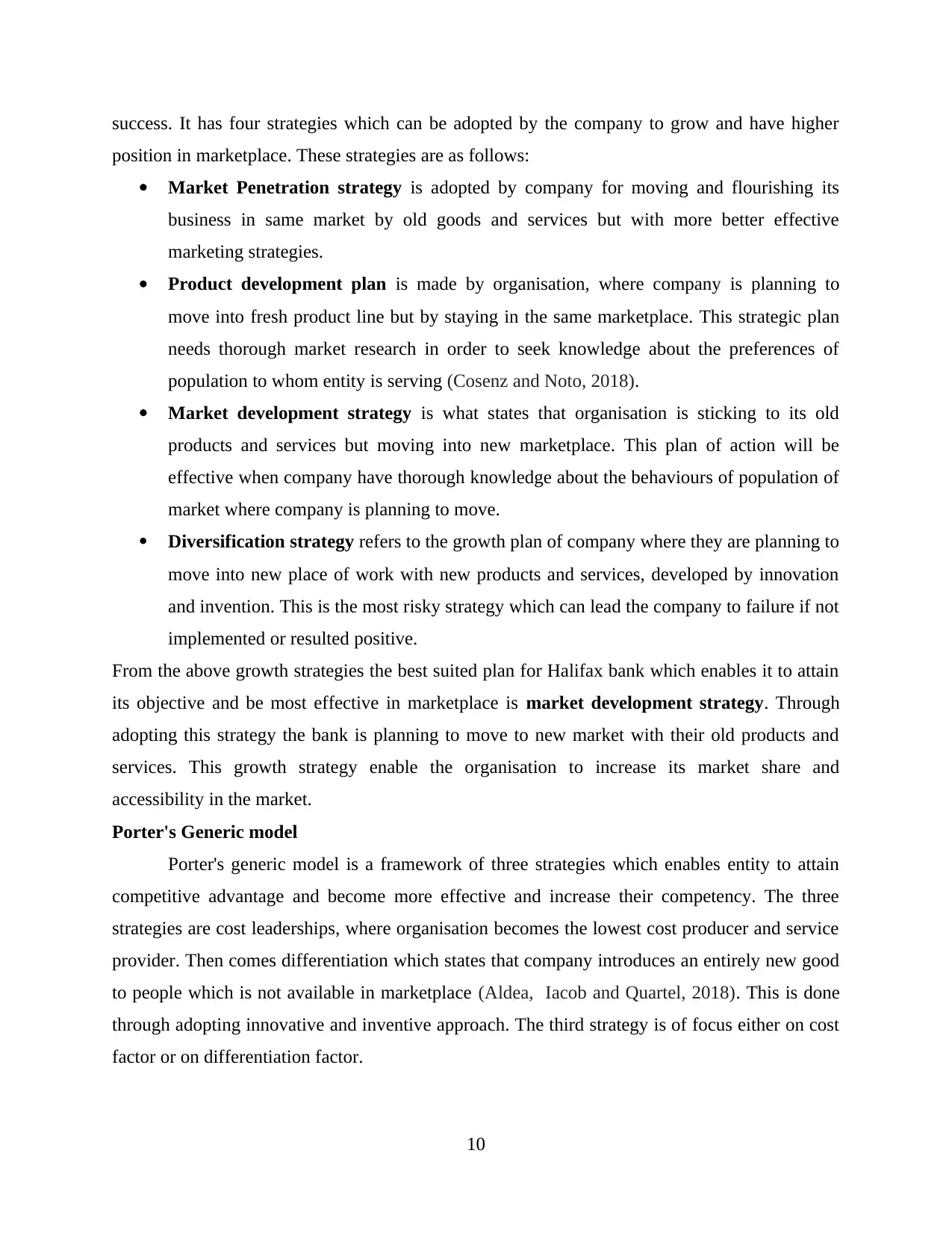
success. It has four strategies which can be adopted by the company to grow and have higher
position in marketplace. These strategies are as follows:
Market Penetration strategy is adopted by company for moving and flourishing its
business in same market by old goods and services but with more better effective
marketing strategies.
Product development plan is made by organisation, where company is planning to
move into fresh product line but by staying in the same marketplace. This strategic plan
needs thorough market research in order to seek knowledge about the preferences of
population to whom entity is serving (Cosenz and Noto, 2018).
Market development strategy is what states that organisation is sticking to its old
products and services but moving into new marketplace. This plan of action will be
effective when company have thorough knowledge about the behaviours of population of
market where company is planning to move.
Diversification strategy refers to the growth plan of company where they are planning to
move into new place of work with new products and services, developed by innovation
and invention. This is the most risky strategy which can lead the company to failure if not
implemented or resulted positive.
From the above growth strategies the best suited plan for Halifax bank which enables it to attain
its objective and be most effective in marketplace is market development strategy. Through
adopting this strategy the bank is planning to move to new market with their old products and
services. This growth strategy enable the organisation to increase its market share and
accessibility in the market.
Porter's Generic model
Porter's generic model is a framework of three strategies which enables entity to attain
competitive advantage and become more effective and increase their competency. The three
strategies are cost leaderships, where organisation becomes the lowest cost producer and service
provider. Then comes differentiation which states that company introduces an entirely new good
to people which is not available in marketplace (Aldea, Iacob and Quartel, 2018). This is done
through adopting innovative and inventive approach. The third strategy is of focus either on cost
factor or on differentiation factor.
10
position in marketplace. These strategies are as follows:
Market Penetration strategy is adopted by company for moving and flourishing its
business in same market by old goods and services but with more better effective
marketing strategies.
Product development plan is made by organisation, where company is planning to
move into fresh product line but by staying in the same marketplace. This strategic plan
needs thorough market research in order to seek knowledge about the preferences of
population to whom entity is serving (Cosenz and Noto, 2018).
Market development strategy is what states that organisation is sticking to its old
products and services but moving into new marketplace. This plan of action will be
effective when company have thorough knowledge about the behaviours of population of
market where company is planning to move.
Diversification strategy refers to the growth plan of company where they are planning to
move into new place of work with new products and services, developed by innovation
and invention. This is the most risky strategy which can lead the company to failure if not
implemented or resulted positive.
From the above growth strategies the best suited plan for Halifax bank which enables it to attain
its objective and be most effective in marketplace is market development strategy. Through
adopting this strategy the bank is planning to move to new market with their old products and
services. This growth strategy enable the organisation to increase its market share and
accessibility in the market.
Porter's Generic model
Porter's generic model is a framework of three strategies which enables entity to attain
competitive advantage and become more effective and increase their competency. The three
strategies are cost leaderships, where organisation becomes the lowest cost producer and service
provider. Then comes differentiation which states that company introduces an entirely new good
to people which is not available in marketplace (Aldea, Iacob and Quartel, 2018). This is done
through adopting innovative and inventive approach. The third strategy is of focus either on cost
factor or on differentiation factor.
10
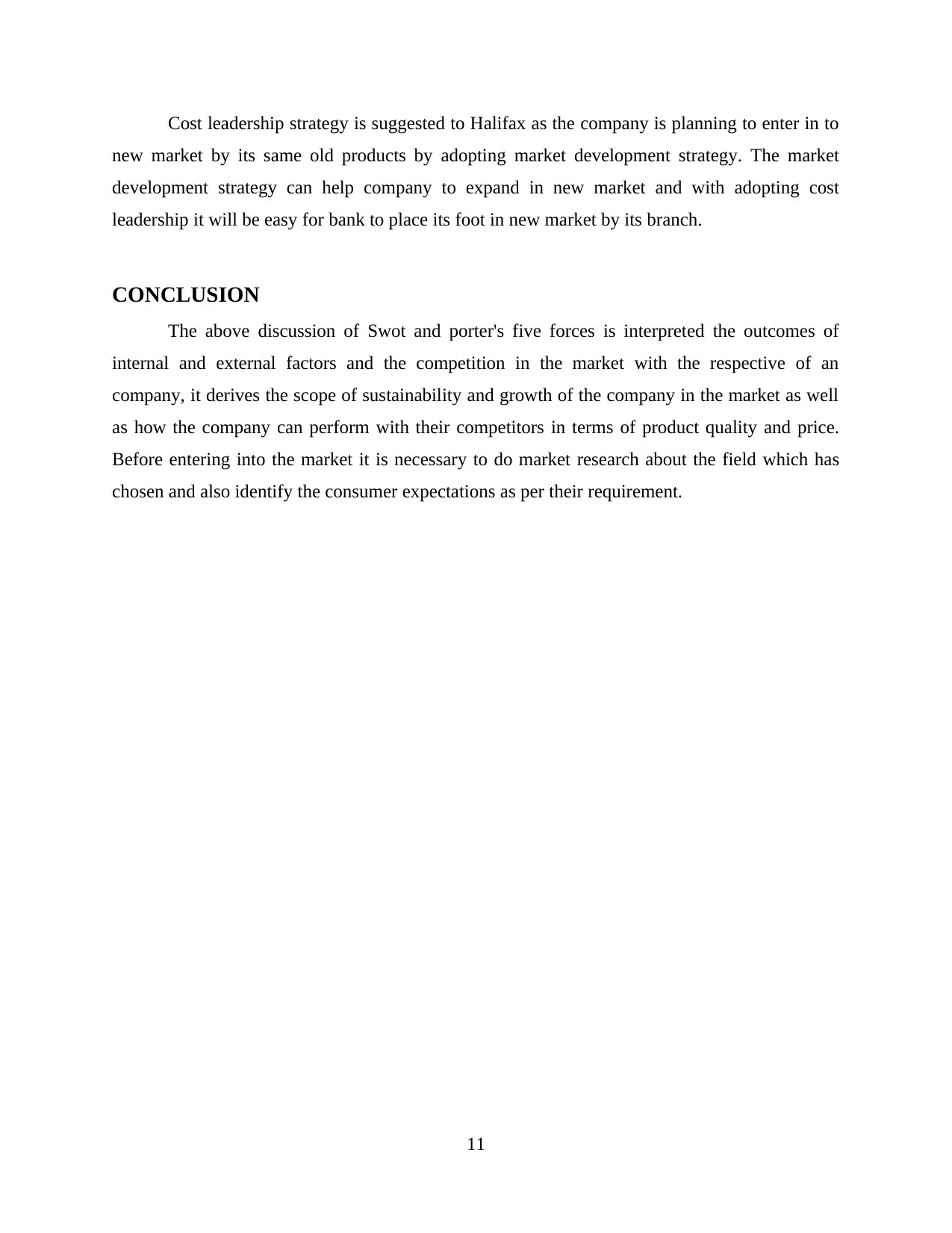
Cost leadership strategy is suggested to Halifax as the company is planning to enter in to
new market by its same old products by adopting market development strategy. The market
development strategy can help company to expand in new market and with adopting cost
leadership it will be easy for bank to place its foot in new market by its branch.
CONCLUSION
The above discussion of Swot and porter's five forces is interpreted the outcomes of
internal and external factors and the competition in the market with the respective of an
company, it derives the scope of sustainability and growth of the company in the market as well
as how the company can perform with their competitors in terms of product quality and price.
Before entering into the market it is necessary to do market research about the field which has
chosen and also identify the consumer expectations as per their requirement.
11
new market by its same old products by adopting market development strategy. The market
development strategy can help company to expand in new market and with adopting cost
leadership it will be easy for bank to place its foot in new market by its branch.
CONCLUSION
The above discussion of Swot and porter's five forces is interpreted the outcomes of
internal and external factors and the competition in the market with the respective of an
company, it derives the scope of sustainability and growth of the company in the market as well
as how the company can perform with their competitors in terms of product quality and price.
Before entering into the market it is necessary to do market research about the field which has
chosen and also identify the consumer expectations as per their requirement.
11
Paraphrase This Document
Need a fresh take? Get an instant paraphrase of this document with our AI Paraphraser
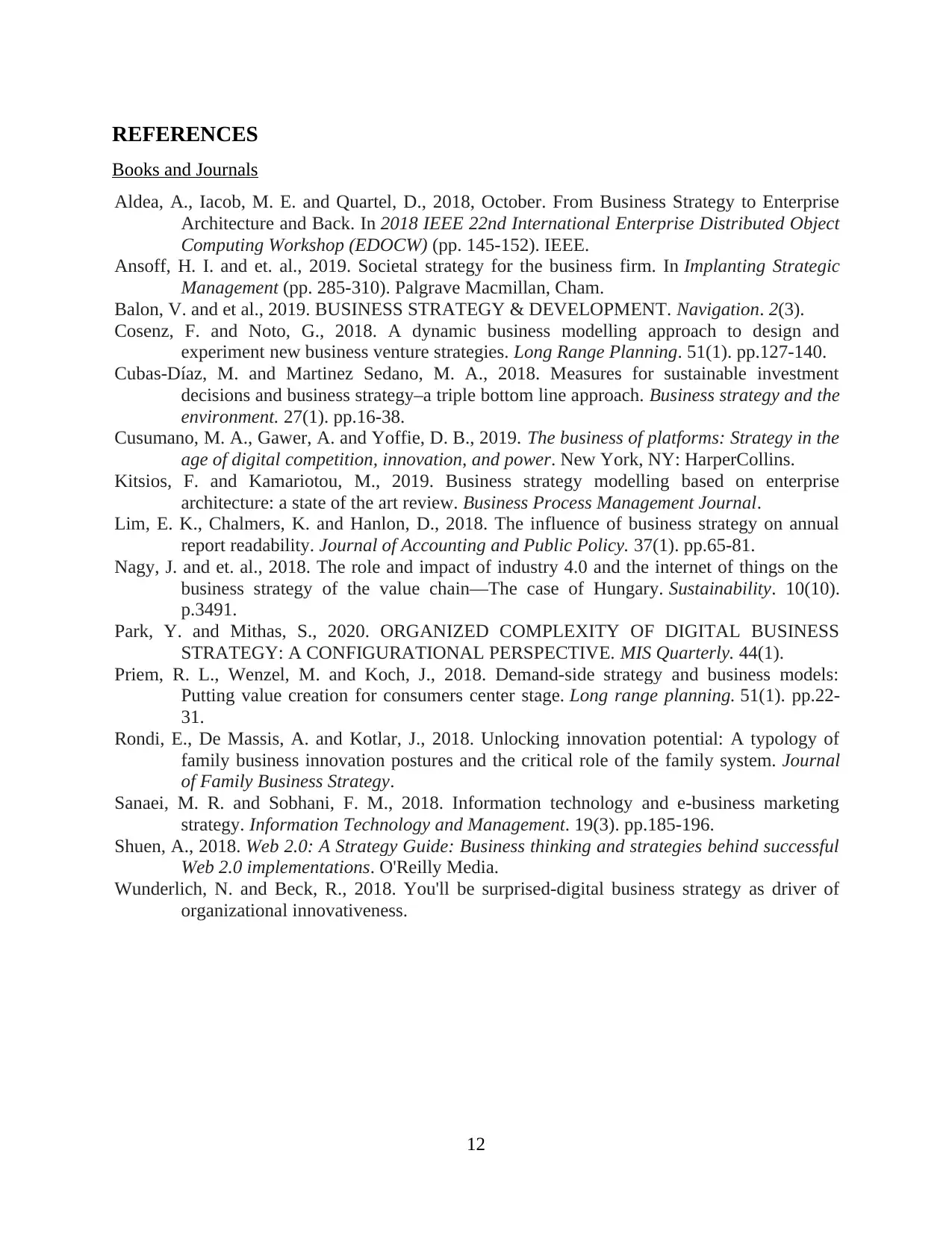
REFERENCES
Books and Journals
Aldea, A., Iacob, M. E. and Quartel, D., 2018, October. From Business Strategy to Enterprise
Architecture and Back. In 2018 IEEE 22nd International Enterprise Distributed Object
Computing Workshop (EDOCW) (pp. 145-152). IEEE.
Ansoff, H. I. and et. al., 2019. Societal strategy for the business firm. In Implanting Strategic
Management (pp. 285-310). Palgrave Macmillan, Cham.
Balon, V. and et al., 2019. BUSINESS STRATEGY & DEVELOPMENT. Navigation. 2(3).
Cosenz, F. and Noto, G., 2018. A dynamic business modelling approach to design and
experiment new business venture strategies. Long Range Planning. 51(1). pp.127-140.
Cubas‐Díaz, M. and Martinez Sedano, M. A., 2018. Measures for sustainable investment
decisions and business strategy–a triple bottom line approach. Business strategy and the
environment. 27(1). pp.16-38.
Cusumano, M. A., Gawer, A. and Yoffie, D. B., 2019. The business of platforms: Strategy in the
age of digital competition, innovation, and power. New York, NY: HarperCollins.
Kitsios, F. and Kamariotou, M., 2019. Business strategy modelling based on enterprise
architecture: a state of the art review. Business Process Management Journal.
Lim, E. K., Chalmers, K. and Hanlon, D., 2018. The influence of business strategy on annual
report readability. Journal of Accounting and Public Policy. 37(1). pp.65-81.
Nagy, J. and et. al., 2018. The role and impact of industry 4.0 and the internet of things on the
business strategy of the value chain—The case of Hungary. Sustainability. 10(10).
p.3491.
Park, Y. and Mithas, S., 2020. ORGANIZED COMPLEXITY OF DIGITAL BUSINESS
STRATEGY: A CONFIGURATIONAL PERSPECTIVE. MIS Quarterly. 44(1).
Priem, R. L., Wenzel, M. and Koch, J., 2018. Demand-side strategy and business models:
Putting value creation for consumers center stage. Long range planning. 51(1). pp.22-
31.
Rondi, E., De Massis, A. and Kotlar, J., 2018. Unlocking innovation potential: A typology of
family business innovation postures and the critical role of the family system. Journal
of Family Business Strategy.
Sanaei, M. R. and Sobhani, F. M., 2018. Information technology and e-business marketing
strategy. Information Technology and Management. 19(3). pp.185-196.
Shuen, A., 2018. Web 2.0: A Strategy Guide: Business thinking and strategies behind successful
Web 2.0 implementations. O'Reilly Media.
Wunderlich, N. and Beck, R., 2018. You'll be surprised-digital business strategy as driver of
organizational innovativeness.
12
Books and Journals
Aldea, A., Iacob, M. E. and Quartel, D., 2018, October. From Business Strategy to Enterprise
Architecture and Back. In 2018 IEEE 22nd International Enterprise Distributed Object
Computing Workshop (EDOCW) (pp. 145-152). IEEE.
Ansoff, H. I. and et. al., 2019. Societal strategy for the business firm. In Implanting Strategic
Management (pp. 285-310). Palgrave Macmillan, Cham.
Balon, V. and et al., 2019. BUSINESS STRATEGY & DEVELOPMENT. Navigation. 2(3).
Cosenz, F. and Noto, G., 2018. A dynamic business modelling approach to design and
experiment new business venture strategies. Long Range Planning. 51(1). pp.127-140.
Cubas‐Díaz, M. and Martinez Sedano, M. A., 2018. Measures for sustainable investment
decisions and business strategy–a triple bottom line approach. Business strategy and the
environment. 27(1). pp.16-38.
Cusumano, M. A., Gawer, A. and Yoffie, D. B., 2019. The business of platforms: Strategy in the
age of digital competition, innovation, and power. New York, NY: HarperCollins.
Kitsios, F. and Kamariotou, M., 2019. Business strategy modelling based on enterprise
architecture: a state of the art review. Business Process Management Journal.
Lim, E. K., Chalmers, K. and Hanlon, D., 2018. The influence of business strategy on annual
report readability. Journal of Accounting and Public Policy. 37(1). pp.65-81.
Nagy, J. and et. al., 2018. The role and impact of industry 4.0 and the internet of things on the
business strategy of the value chain—The case of Hungary. Sustainability. 10(10).
p.3491.
Park, Y. and Mithas, S., 2020. ORGANIZED COMPLEXITY OF DIGITAL BUSINESS
STRATEGY: A CONFIGURATIONAL PERSPECTIVE. MIS Quarterly. 44(1).
Priem, R. L., Wenzel, M. and Koch, J., 2018. Demand-side strategy and business models:
Putting value creation for consumers center stage. Long range planning. 51(1). pp.22-
31.
Rondi, E., De Massis, A. and Kotlar, J., 2018. Unlocking innovation potential: A typology of
family business innovation postures and the critical role of the family system. Journal
of Family Business Strategy.
Sanaei, M. R. and Sobhani, F. M., 2018. Information technology and e-business marketing
strategy. Information Technology and Management. 19(3). pp.185-196.
Shuen, A., 2018. Web 2.0: A Strategy Guide: Business thinking and strategies behind successful
Web 2.0 implementations. O'Reilly Media.
Wunderlich, N. and Beck, R., 2018. You'll be surprised-digital business strategy as driver of
organizational innovativeness.
12
1 out of 14
Related Documents
Your All-in-One AI-Powered Toolkit for Academic Success.
+13062052269
info@desklib.com
Available 24*7 on WhatsApp / Email
![[object Object]](/_next/static/media/star-bottom.7253800d.svg)
Unlock your academic potential
© 2024 | Zucol Services PVT LTD | All rights reserved.



